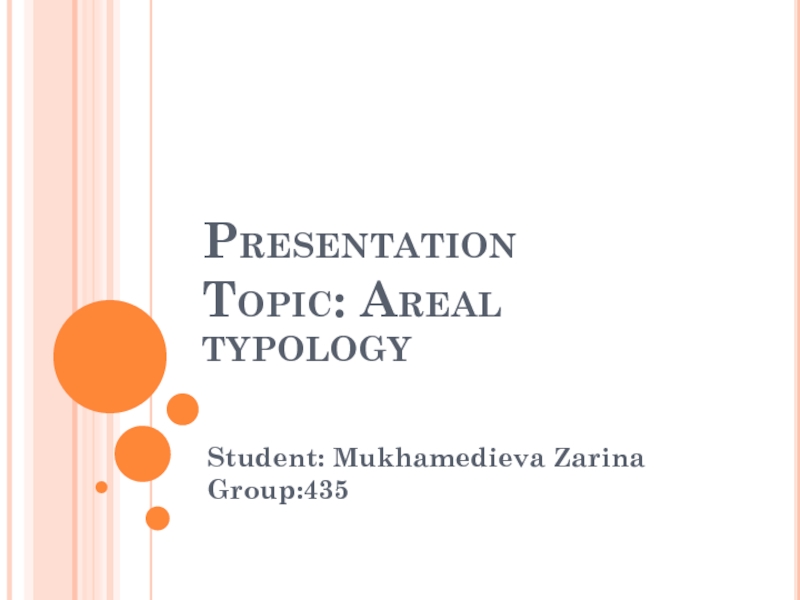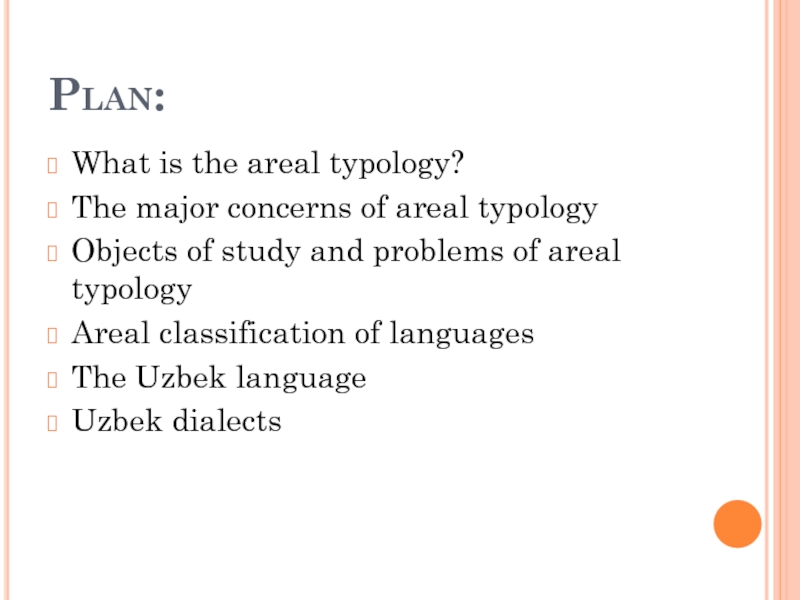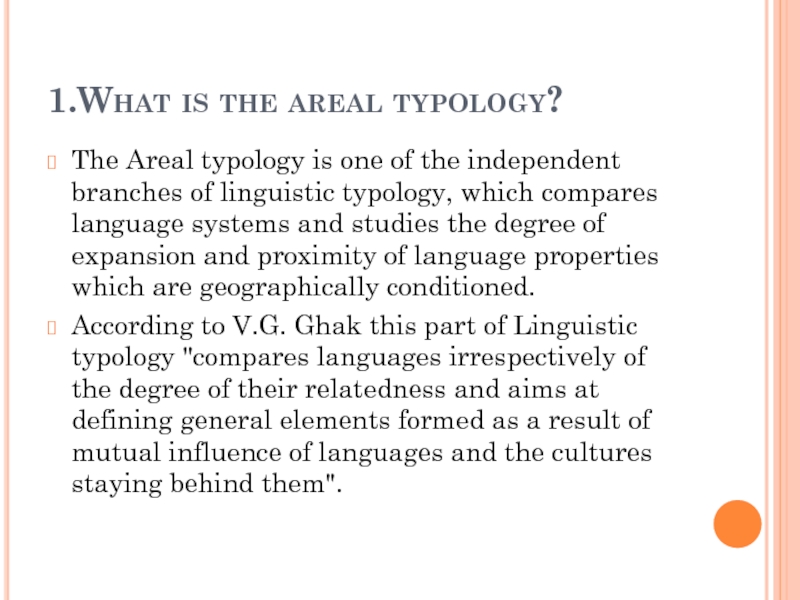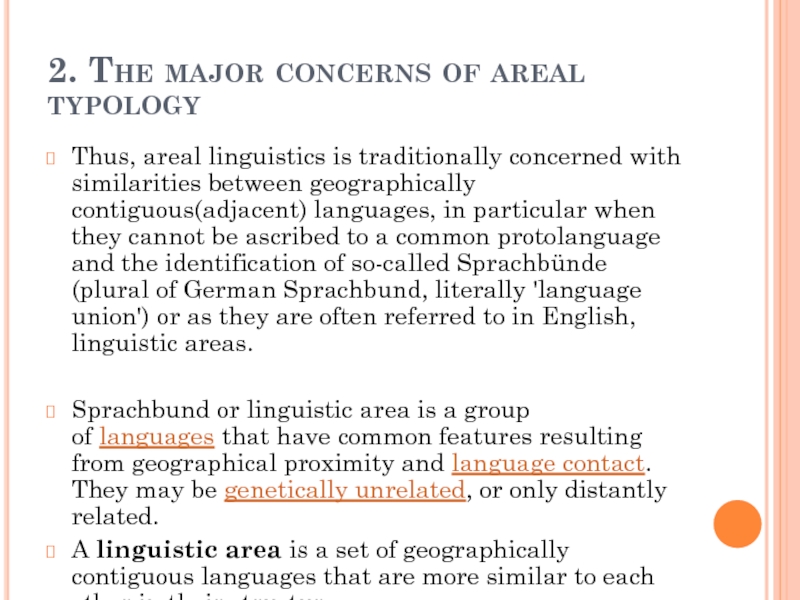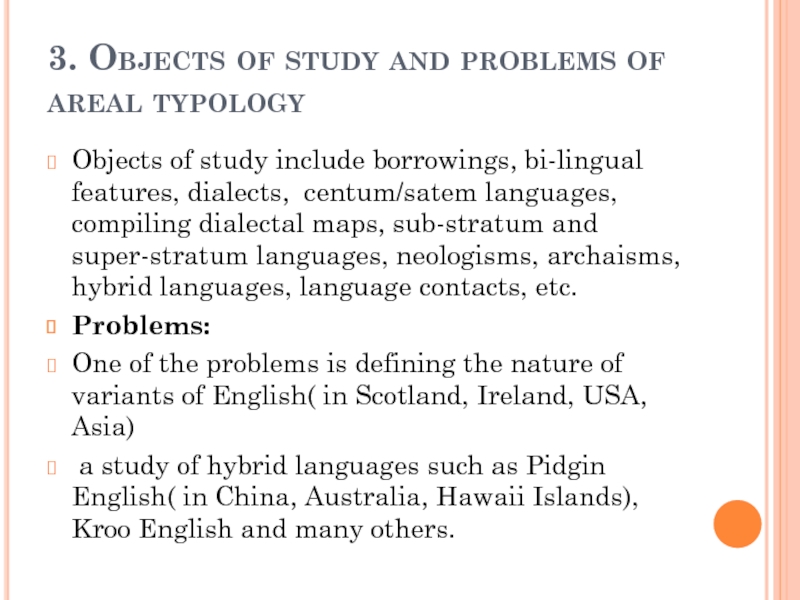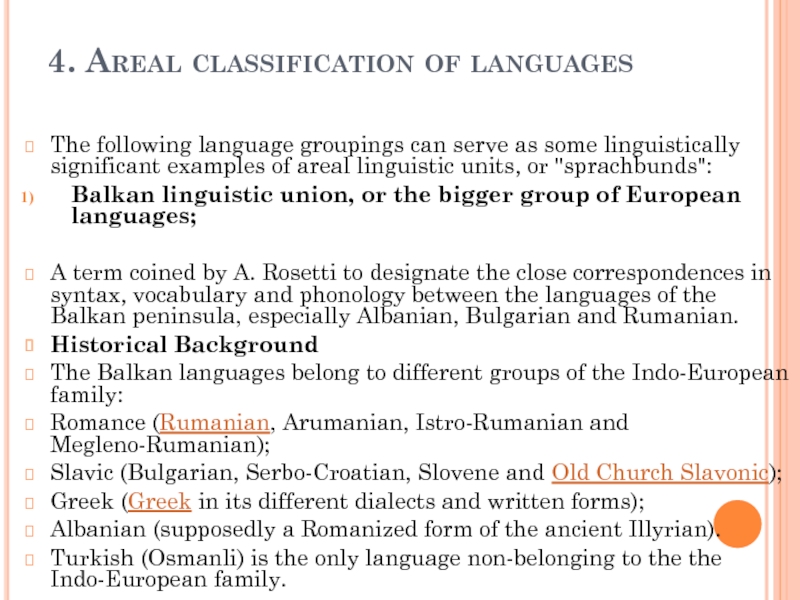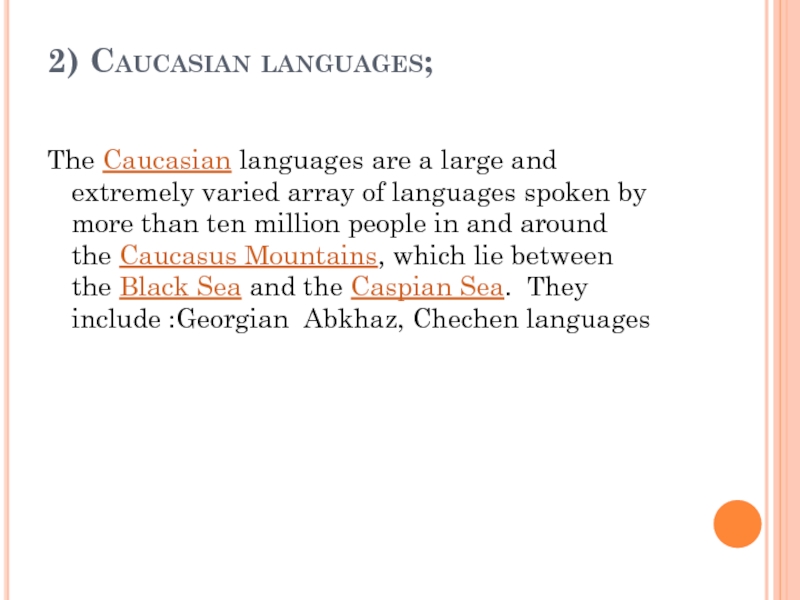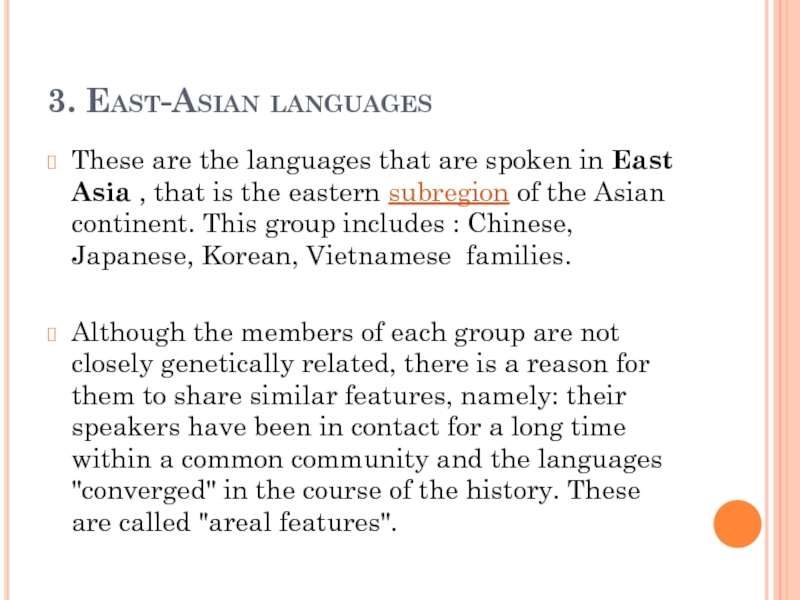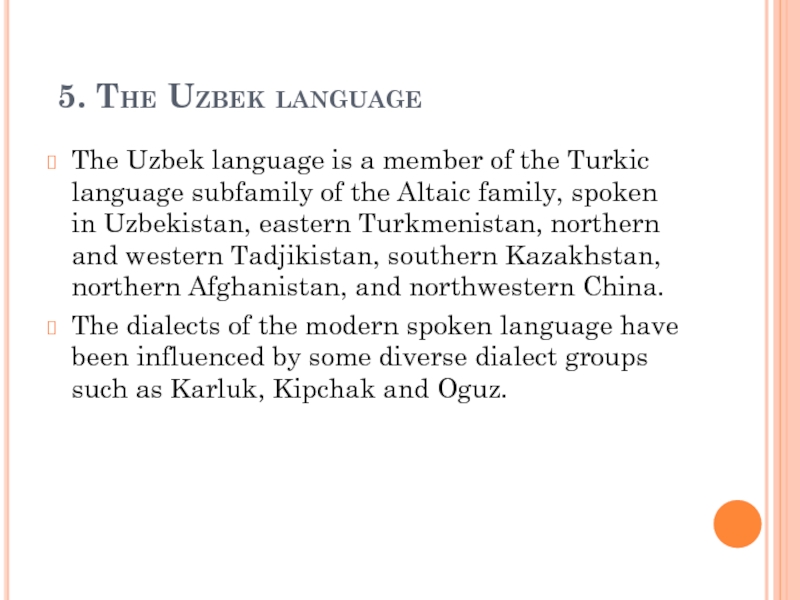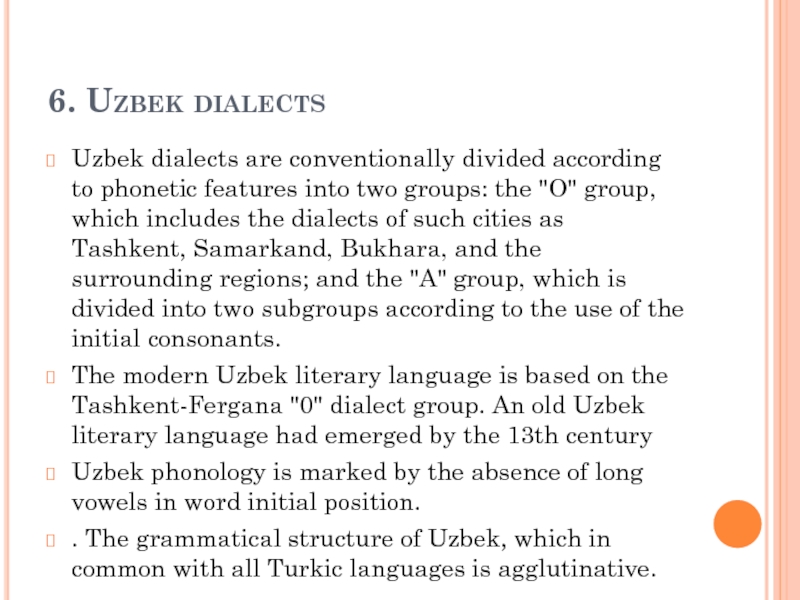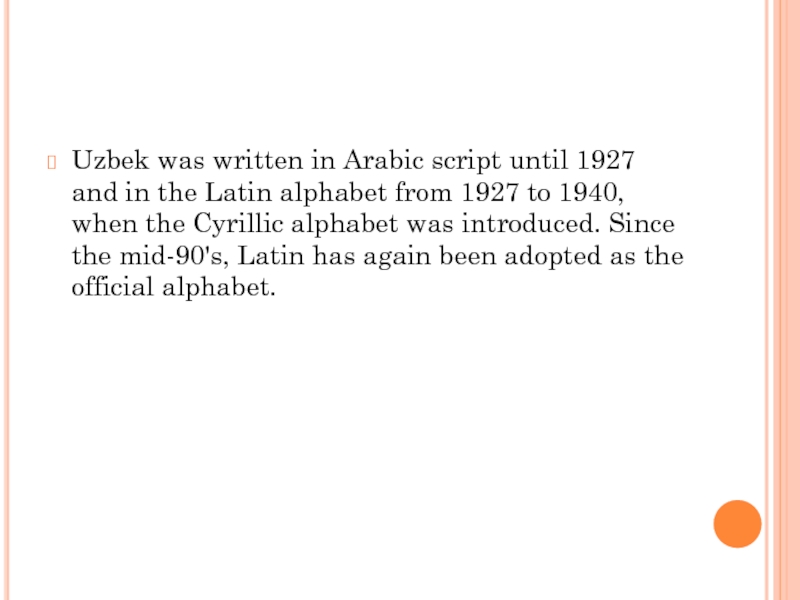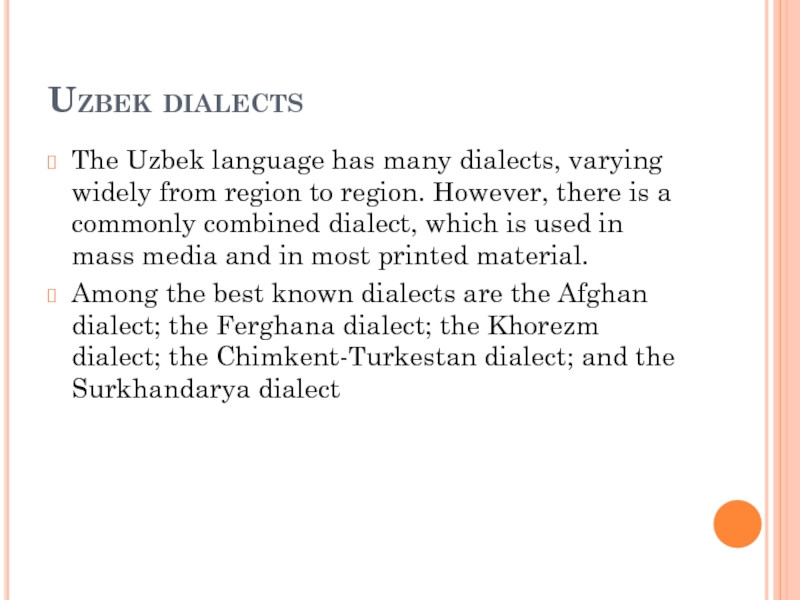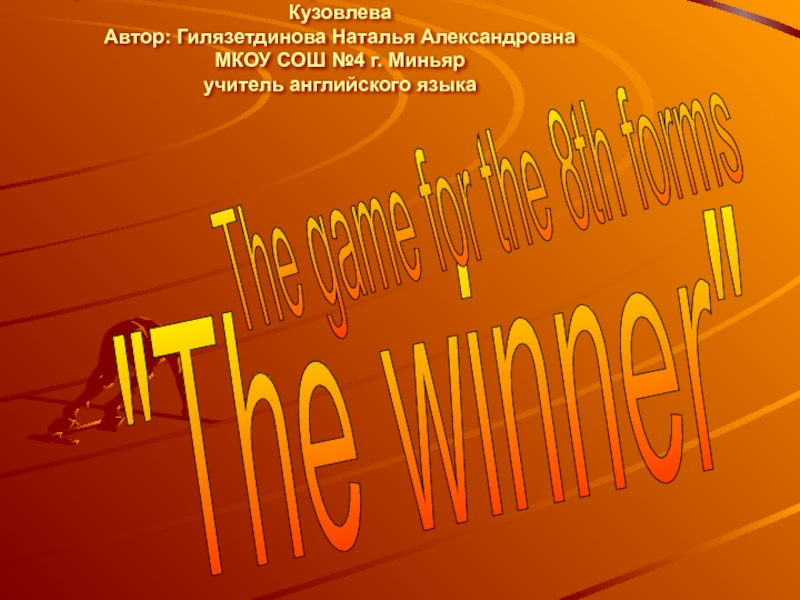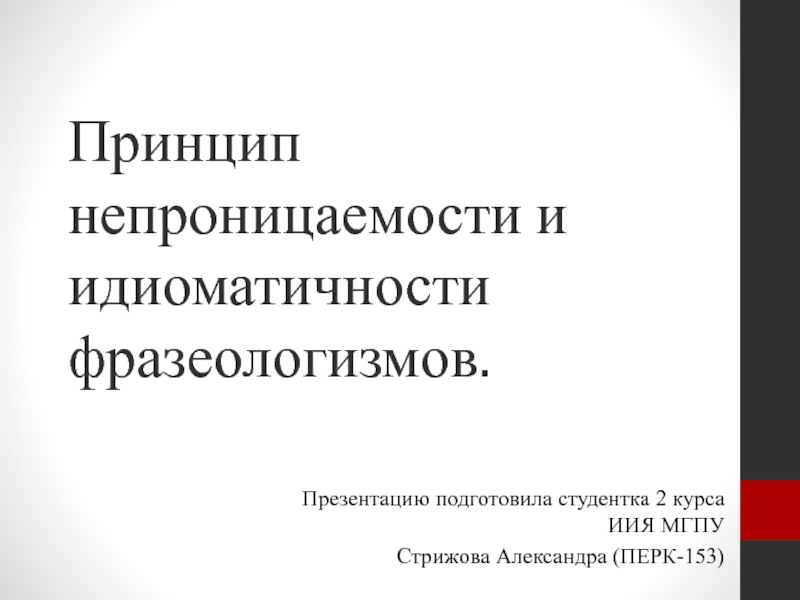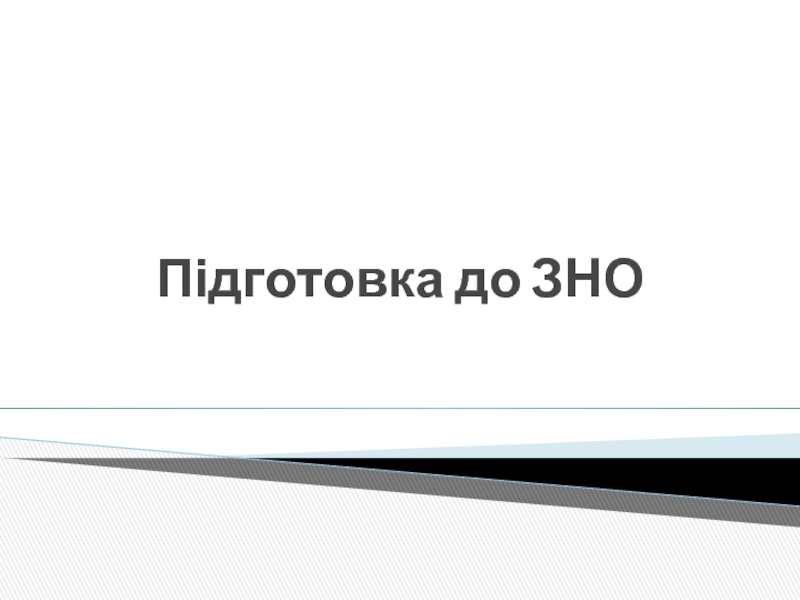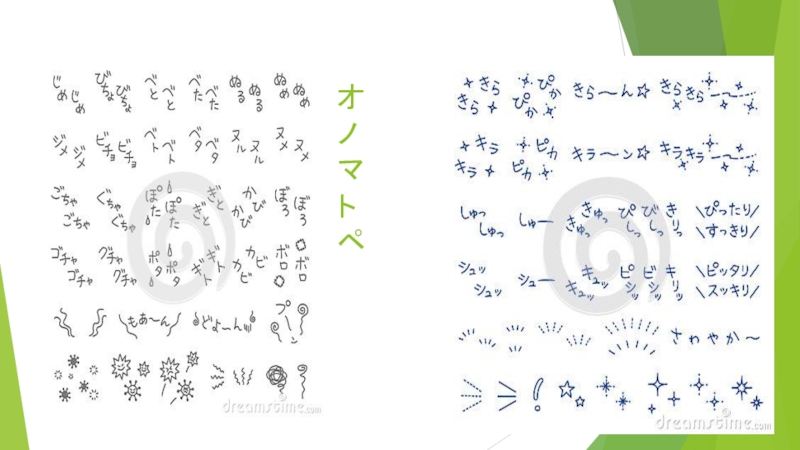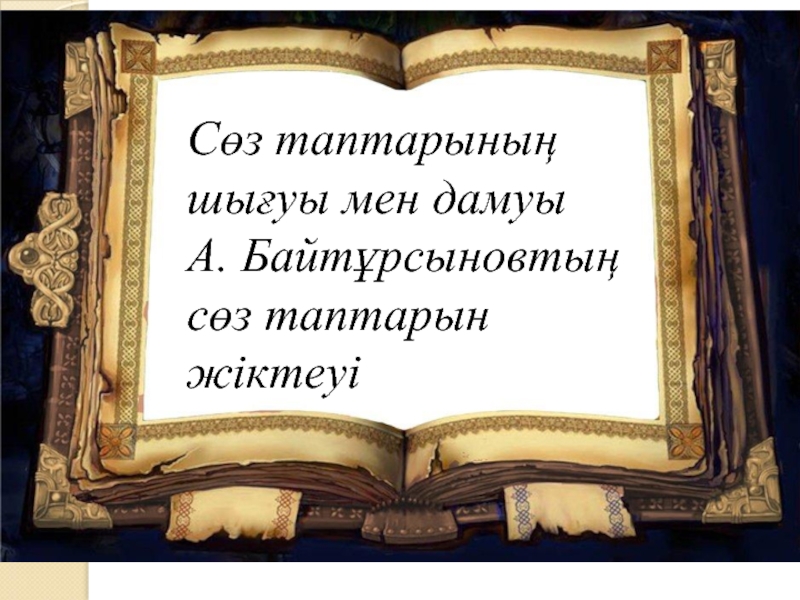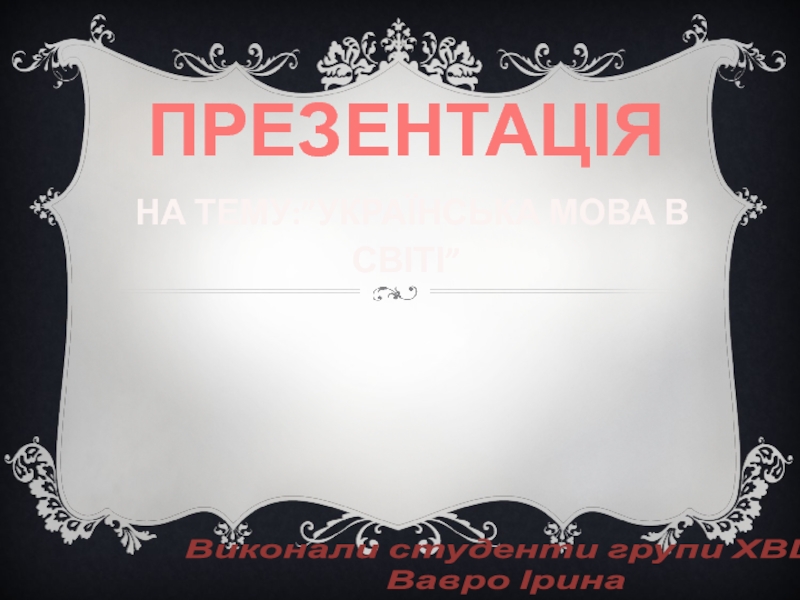- Главная
- Разное
- Дизайн
- Бизнес и предпринимательство
- Аналитика
- Образование
- Развлечения
- Красота и здоровье
- Финансы
- Государство
- Путешествия
- Спорт
- Недвижимость
- Армия
- Графика
- Культурология
- Еда и кулинария
- Лингвистика
- Английский язык
- Астрономия
- Алгебра
- Биология
- География
- Детские презентации
- Информатика
- История
- Литература
- Маркетинг
- Математика
- Медицина
- Менеджмент
- Музыка
- МХК
- Немецкий язык
- ОБЖ
- Обществознание
- Окружающий мир
- Педагогика
- Русский язык
- Технология
- Физика
- Философия
- Химия
- Шаблоны, картинки для презентаций
- Экология
- Экономика
- Юриспруденция
Areal typology презентация
Содержание
- 1. Areal typology
- 2. Plan: What is the areal typology? The
- 3. 1.What is the areal typology? The Areal
- 4. 2. The major concerns of areal typology
- 5. 3. Objects of study and problems of
- 6. 4. Areal classification of languages The
- 7. 2) Caucasian languages; The Caucasian languages are a
- 8. 3. East-Asian languages These are the languages
- 9. 5. The Uzbek language The Uzbek language
- 10. 6. Uzbek dialects Uzbek dialects are conventionally
- 11. Uzbek was written in Arabic script
- 12. Uzbek dialects The Uzbek language has many
Слайд 2Plan:
What is the areal typology?
The major concerns of areal typology
Objects of
study and problems of areal typology
Areal classification of languages
The Uzbek language
Uzbek dialects
Areal classification of languages
The Uzbek language
Uzbek dialects
Слайд 31.What is the areal typology?
The Areal typology is one of the
independent branches of linguistic typology, which compares language systems and studies the degree of expansion and proximity of language properties which are geographically conditioned.
According to V.G. Ghak this part of Linguistic typology "compares languages irrespectively of the degree of their relatedness and aims at defining general elements formed as a result of mutual influence of languages and the cultures staying behind them".
According to V.G. Ghak this part of Linguistic typology "compares languages irrespectively of the degree of their relatedness and aims at defining general elements formed as a result of mutual influence of languages and the cultures staying behind them".
Слайд 42. The major concerns of areal typology
Thus, areal linguistics is traditionally
concerned with similarities between geographically contiguous(adjacent) languages, in particular when they cannot be ascribed to a common protolanguage and the identification of so-called Sprachbünde (plural of German Sprachbund, literally 'language union') or as they are often referred to in English, linguistic areas.
Sprachbund or linguistic area is a group of languages that have common features resulting from geographical proximity and language contact. They may be genetically unrelated, or only distantly related.
A linguistic area is a set of geographically contiguous languages that are more similar to each other in their structure
Sprachbund or linguistic area is a group of languages that have common features resulting from geographical proximity and language contact. They may be genetically unrelated, or only distantly related.
A linguistic area is a set of geographically contiguous languages that are more similar to each other in their structure
Слайд 53. Objects of study and problems of areal typology
Objects of study
include borrowings, bi-lingual features, dialects, centum/satem languages, compiling dialectal maps, sub-stratum and super-stratum languages, neologisms, archaisms, hybrid languages, language contacts, etc.
Problems:
One of the problems is defining the nature of variants of English( in Scotland, Ireland, USA, Asia)
a study of hybrid languages such as Pidgin English( in China, Australia, Hawaii Islands), Kroo English and many others.
Problems:
One of the problems is defining the nature of variants of English( in Scotland, Ireland, USA, Asia)
a study of hybrid languages such as Pidgin English( in China, Australia, Hawaii Islands), Kroo English and many others.
Слайд 64. Areal classification of languages
The following language groupings can serve as
some linguistically significant examples of areal linguistic units, or "sprachbunds":
Balkan linguistic union, or the bigger group of European languages;
A term coined by A. Rosetti to designate the close correspondences in syntax, vocabulary and phonology between the languages of the Balkan peninsula, especially Albanian, Bulgarian and Rumanian.
Historical Background
The Balkan languages belong to different groups of the Indo-European family:
Romance (Rumanian, Arumanian, Istro-Rumanian and Megleno-Rumanian);
Slavic (Bulgarian, Serbo-Croatian, Slovene and Old Church Slavonic);
Greek (Greek in its different dialects and written forms);
Albanian (supposedly a Romanized form of the ancient Illyrian).
Turkish (Osmanli) is the only language non-belonging to the the Indo-European family.
Balkan linguistic union, or the bigger group of European languages;
A term coined by A. Rosetti to designate the close correspondences in syntax, vocabulary and phonology between the languages of the Balkan peninsula, especially Albanian, Bulgarian and Rumanian.
Historical Background
The Balkan languages belong to different groups of the Indo-European family:
Romance (Rumanian, Arumanian, Istro-Rumanian and Megleno-Rumanian);
Slavic (Bulgarian, Serbo-Croatian, Slovene and Old Church Slavonic);
Greek (Greek in its different dialects and written forms);
Albanian (supposedly a Romanized form of the ancient Illyrian).
Turkish (Osmanli) is the only language non-belonging to the the Indo-European family.
Слайд 72) Caucasian languages;
The Caucasian languages are a large and extremely varied array of
languages spoken by more than ten million people in and around the Caucasus Mountains, which lie between the Black Sea and the Caspian Sea. They include :Georgian Abkhaz, Chechen languages
Слайд 83. East-Asian languages
These are the languages that are spoken in East
Asia , that is the eastern subregion of the Asian continent. This group includes : Chinese, Japanese, Korean, Vietnamese families.
Although the members of each group are not closely genetically related, there is a reason for them to share similar features, namely: their speakers have been in contact for a long time within a common community and the languages "converged" in the course of the history. These are called "areal features".
Although the members of each group are not closely genetically related, there is a reason for them to share similar features, namely: their speakers have been in contact for a long time within a common community and the languages "converged" in the course of the history. These are called "areal features".
Слайд 95. The Uzbek language
The Uzbek language is a member of the
Turkic language subfamily of the Altaic family, spoken in Uzbekistan, eastern Turkmenistan, northern and western Tadjikistan, southern Kazakhstan, northern Afghanistan, and northwestern China.
The dialects of the modern spoken language have been influenced by some diverse dialect groups such as Karluk, Kipchak and Oguz.
The dialects of the modern spoken language have been influenced by some diverse dialect groups such as Karluk, Kipchak and Oguz.
Слайд 106. Uzbek dialects
Uzbek dialects are conventionally divided according to phonetic features
into two groups: the "O" group, which includes the dialects of such cities as Tashkent, Samarkand, Bukhara, and the surrounding regions; and the "A" group, which is divided into two subgroups according to the use of the initial consonants.
The modern Uzbek literary language is based on the Tashkent-Fergana "0" dialect group. An old Uzbek literary language had emerged by the 13th century
Uzbek phonology is marked by the absence of long vowels in word initial position.
. The grammatical structure of Uzbek, which in common with all Turkic languages is agglutinative.
The modern Uzbek literary language is based on the Tashkent-Fergana "0" dialect group. An old Uzbek literary language had emerged by the 13th century
Uzbek phonology is marked by the absence of long vowels in word initial position.
. The grammatical structure of Uzbek, which in common with all Turkic languages is agglutinative.
Слайд 11
Uzbek was written in Arabic script until 1927 and in the
Latin alphabet from 1927 to 1940, when the Cyrillic alphabet was introduced. Since the mid-90's, Latin has again been adopted as the official alphabet.
Слайд 12Uzbek dialects
The Uzbek language has many dialects, varying widely from region
to region. However, there is a commonly combined dialect, which is used in mass media and in most printed material.
Among the best known dialects are the Afghan dialect; the Ferghana dialect; the Khorezm dialect; the Chimkent-Turkestan dialect; and the Surkhandarya dialect
Among the best known dialects are the Afghan dialect; the Ferghana dialect; the Khorezm dialect; the Chimkent-Turkestan dialect; and the Surkhandarya dialect
